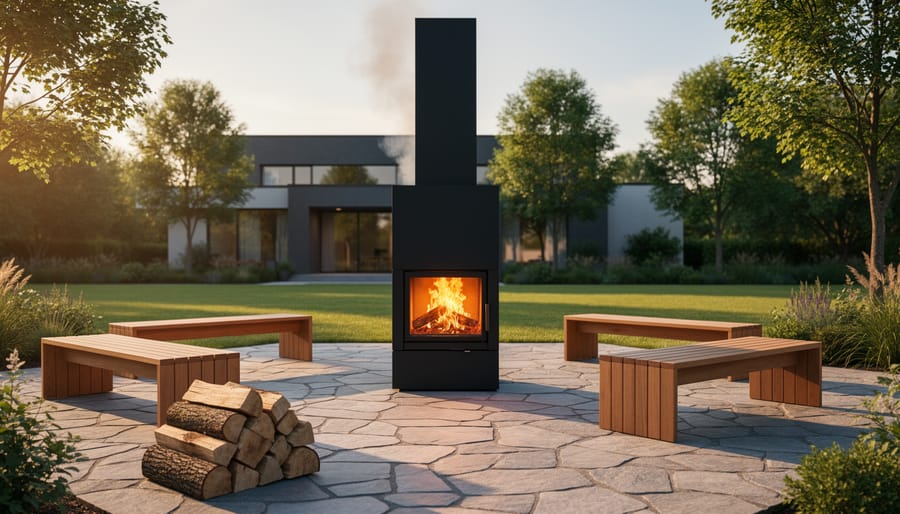Looking to heat your home in an eco-friendly way? Look no further! In this article, we will explore the idea of fireside sustainability and how it can help you keep warm while also being kind to the environment.
Whether you have a fireplace, a wood-burning stove, or even a portable fire pit, there are plenty of options available to make your home heating more sustainable. From using renewable wood sources to ensuring efficient combustion, we will provide you with tips and tricks to reduce your carbon footprint without sacrificing warmth and comfort. So, sit back, cozy up, and let’s dive into the world of eco-friendly heating solutions.
Benefits of Eco-Friendly Heating Options
When it comes to heating your home, opting for eco-friendly solutions offers numerous benefits. Not only do these options help reduce your carbon footprint, but they can also save you money on energy bills in the long run.
Eco-friendly heating systems are efficient. They can convert a larger percentage of the fuel into heat. This efficiency translates to lower energy consumption, resulting in reduced greenhouse gas emissions.
Additionally, eco-friendly heating options often utilize renewable energy sources, such as wood, pellets, or solar power. By relying on renewable resources, you can ensure a sustainable heat source for your home while reducing your dependence on fossil fuels.
Common Eco-Friendly Heating Systems
There are several eco-friendly heating systems available on the market today. One popular option is a wood-burning stove, which can efficiently heat a single room or even an entire home. Wood-burning stoves are known for their high heat output and low emissions when properly operated. They allow you to utilize sustainably sourced firewood, making them a great choice for environmentally conscious homeowners.
Another common eco-friendly heating system is an electric fireplace, which can add warmth and ambiance to any living space. By choosing a fireplace with an energy-efficient design, you can maximize heat output while minimizing energy waste. Additionally, you have the option to power an electric heater with renewable energy – for example, if you use solar power.
The best solar panels for powering a home are usually installed on rooftops and can supply enough power to run your home on an entirely renewable, clean and sustainable energy source. They are emissions-free and can provide you with power even if the national grid blacks out.
For those looking for a portable heating solution, a fire pit powered by wood or bioethanol can be a great option. These portable fire pits are not only eco-friendly but also provide a cozy atmosphere for outdoor gatherings. Whether you’re camping or simply enjoying your backyard, a fire pit can keep you warm without harming the environment.
Tips for Reducing Energy Consumption in Heating
Reducing energy consumption is key to achieving fireside sustainability. Here are some practical tips to help you lower your energy usage while keeping your home warm and comfortable:
- Seal Air Leaks: Inspect your home for air leaks around windows, doors, and other openings. Properly sealing these areas can prevent heat from escaping, reducing energy waste.
- Use Ceiling Fans: In winter, set your ceiling fans to run in reverse mode at a low speed. This helps circulate warm air throughout the room, allowing you to lower the thermostat, or fire, without sacrificing comfort.
- Regular Maintenance: Schedule regular maintenance for your heating system to ensure it operates at peak efficiency. This includes cleaning or replacing air filters, inspecting ductwork, and checking for any potential issues.
- Natural Sunlight: Take advantage of natural sunlight by keeping curtains and blinds open during the day. This allows the sun’s warmth to naturally heat your home, reducing the need for artificial heating.
Renewable Energy Sources for Heating
Renewable energy sources play a significant role in all aspects of sustainable living. When it comes to heating your home, there are several renewable options you can consider:
Biomass: Biomass heating systems use organic materials like wood pellets, agricultural waste, or dedicated energy crops to produce heat. These materials are renewable and can be sustainably sourced, making biomass a viable eco-friendly heating option.
Solar Power: Solar heating systems capture the sun’s energy and convert it into usable heat for your home. As mentioned, solar panels can be installed on rooftops or in sunny areas of your property to power your home on free, sustainable energy.
Geothermal Energy: Geothermal heating utilizes the earth’s natural heat to warm your home. Pipes are installed underground, allowing heat to be extracted and distributed throughout your property
By tapping into renewable energy sources, you can reduce your reliance on fossil fuels and contribute to a more sustainable future. You can also save hundreds of dollars each year.
Government Incentives for Sustainable Heating
Many governments offer incentives to encourage homeowners to adopt sustainable heating solutions. These incentives can include tax credits, grants, or rebates that help offset the cost of purchasing and installing eco-friendly heating systems.
It’s worth researching the incentives available in your region to see if you qualify for any financial assistance. By taking advantage of these programs, you can make eco-friendly heating even more affordable and accessible.
Choosing the Right Eco-Friendly Heating Option for Your Home
When selecting an eco-friendly heating option for your home, it’s important to consider several factors. Here are some key considerations to help you make an informed decision:
- Heating Needs: Assess your heating needs based on the size of your home and the climate in your region. Some heating systems are more suitable for larger spaces, while others are designed for smaller areas.
- Fuel Availability: Consider the availability and cost of the fuel source required for the heating system. Ensure that the fuel can be sustainably sourced and is readily available in your area.
- Installation Requirements: Evaluate the installation requirements for each heating option. Some systems may require professional installation, while others can be easily installed as a DIY project.
- Budget: Determine your budget for purchasing and installing a heating system. Consider the long-term savings and potential government incentives when calculating the overall cost.
By carefully considering these factors, you can choose the eco-friendly heating option that best suits your home and lifestyle
By opting for eco-friendly heating options and implementing energy-saving practices, you can reduce your carbon footprint while staying warm and cozy. From wood-burning stoves to solar heating systems, there are many choices available to suit your needs and preferences.






